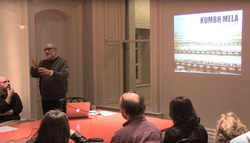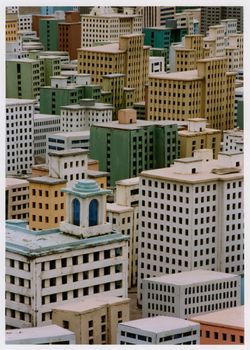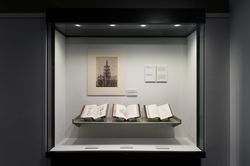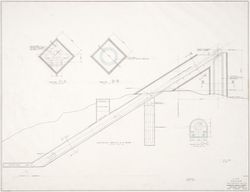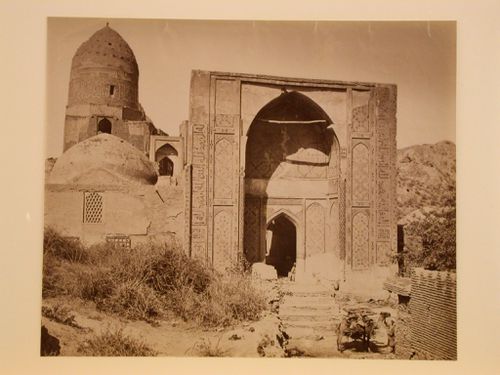Ephemeral landscapes and pop-up settlements are continually increasing in scale and challenging the concept of the city as a stable and permanent entity. For this lecture Rahul Mehrotra, principal of architecture firm RMA Architects and Chair of Urban Planning and Design at the Harvard Graduate School of Design, presents his research on a pop-up settlement called the(...)
Shaughnessy House
13 February 2013 to 12 February 2013
Rahul Mehrota: The Case of the Kumbh Mela in India
Actions:
Description:
Ephemeral landscapes and pop-up settlements are continually increasing in scale and challenging the concept of the city as a stable and permanent entity. For this lecture Rahul Mehrotra, principal of architecture firm RMA Architects and Chair of Urban Planning and Design at the Harvard Graduate School of Design, presents his research on a pop-up settlement called the(...)
Shaughnessy House
Parables and Other Allegories: The Work of Melvin Charney 1975–1990 comprises approximately 100 drawings, including many large-scale, sketches, photographs, and three large constructions. By assembling works from various public and private collections, including the CCA, the exhibition permits a comprehensive analysis of Charney’s artistic process to reveal the dialogue(...)
Main galleries
9 October 1991 to 12 January 1992
Parables and Other Allegories: The Work of Melvin Charney, 1975-1990
Actions:
Description:
Parables and Other Allegories: The Work of Melvin Charney 1975–1990 comprises approximately 100 drawings, including many large-scale, sketches, photographs, and three large constructions. By assembling works from various public and private collections, including the CCA, the exhibition permits a comprehensive analysis of Charney’s artistic process to reveal the dialogue(...)
Main galleries
drawings
DR1981:0024
Description:
- DR1981:0024 shows a design for what appears to be an ornamental footbridge. No dimensions are given and materials are not indicated, but the structure could not have been erected at a very large scale. The road bed consists of three sections: a central flat section supported on a broad flat arch; and two gently-sloped side sections, each supported on seven small, round-headed arches. The span of the bridge is braced between two sets of double piers. Each of these four piers carries an octagonal kiosk consisting of closed panels below and an open framework above. At the centre of the bridge rises a pavilion formed of sixteen columns on a rectangular plan (six columns on each of the two long sides) supporting a curved gable roof. Above the road bed, the superstructure is decorated with banners, lanterns, fretwork, and inscriptions, all in a style of Chinese derivation.
architecture, landscape architecture
ca. 1763
Design for a bridge in the Chinese style to be erected at Sanssouci
Actions:
DR1981:0024
Description:
- DR1981:0024 shows a design for what appears to be an ornamental footbridge. No dimensions are given and materials are not indicated, but the structure could not have been erected at a very large scale. The road bed consists of three sections: a central flat section supported on a broad flat arch; and two gently-sloped side sections, each supported on seven small, round-headed arches. The span of the bridge is braced between two sets of double piers. Each of these four piers carries an octagonal kiosk consisting of closed panels below and an open framework above. At the centre of the bridge rises a pavilion formed of sixteen columns on a rectangular plan (six columns on each of the two long sides) supporting a curved gable roof. Above the road bed, the superstructure is decorated with banners, lanterns, fretwork, and inscriptions, all in a style of Chinese derivation.
drawings
ca. 1763
architecture, landscape architecture
A conversation between Japanese photographer Naoya Hatakeyama and CCA visiting curator Hubertus von Amelunxen on the exhibition Naoya Hatakeyama: Scales. Commissioned by the CCA, Naoya Hatakeyama created three photographic series of architectural models that challenge notions of scale and the perception of reality. He speaks about the series in the context of his work,(...)
Paul Desmarais Theatre
27 September 2007
Naoya Hatakeyama and Hubertus von Amelunxen in Conversation
Actions:
Description:
A conversation between Japanese photographer Naoya Hatakeyama and CCA visiting curator Hubertus von Amelunxen on the exhibition Naoya Hatakeyama: Scales. Commissioned by the CCA, Naoya Hatakeyama created three photographic series of architectural models that challenge notions of scale and the perception of reality. He speaks about the series in the context of his work,(...)
Paul Desmarais Theatre
The Anatomy of the Architectural Book, an exhibition presented in conjunction with the publication of a book of the same title by André Tavares, examines the relationships between book culture and building culture, making visible the axes along which architectural knowledge circulates through books into buildings and back. Through seven themes—Texture, Spread, Sequence,(...)
10 May 2016 to 20 November 2016
The Anatomy of the Architectural Book
Actions:
Description:
The Anatomy of the Architectural Book, an exhibition presented in conjunction with the publication of a book of the same title by André Tavares, examines the relationships between book culture and building culture, making visible the axes along which architectural knowledge circulates through books into buildings and back. Through seven themes—Texture, Spread, Sequence,(...)
photographs
Quantity:
14 File
ARCH261938
Description:
The case contains slides of the Pavilion of Trinidad & Tobago (4), of the Pavilion of India (2, + 3 incorrectly identified as Mexico, + 1 incorrectly identified as Habitat 67 [the grey scale drawing at the right is a representation of the same monument found in front of the Indian Pavilion] = 6), of the Steel Pavilion (1) and of the [Katimavik] (3)***. ***The Katimavik is inscribed on the case ARCH262025, however the corresponding slides are located in case ARCH261938 since there is no space to store them in ARCH262025.
1967
Coloured slides of the Pavilions of Trinidad & Tobago, and Grenada, of India, of the Katimavik and of the Steel Pavilion, Expo 67, Montréal, Québec
Actions:
ARCH261938
Description:
The case contains slides of the Pavilion of Trinidad & Tobago (4), of the Pavilion of India (2, + 3 incorrectly identified as Mexico, + 1 incorrectly identified as Habitat 67 [the grey scale drawing at the right is a representation of the same monument found in front of the Indian Pavilion] = 6), of the Steel Pavilion (1) and of the [Katimavik] (3)***. ***The Katimavik is inscribed on the case ARCH262025, however the corresponding slides are located in case ARCH261938 since there is no space to store them in ARCH262025.
photographs
Quantity:
14 File
1967
DR1988:0437:046
Description:
- This etching for a fireworks construction or macchina is in the form of a temple dedicated to peace. The temple appears to be centrally-planned, consisting of a square lower story crowned by a shallow dome similar to that of the Pantheon except that is roofed with fish-scale shingles. The front façade is in the form of a triumphal arch.
temporary architecture
printed 1773
Etching of Posi's design for the "prima macchina" of 1773
Actions:
DR1988:0437:046
Description:
- This etching for a fireworks construction or macchina is in the form of a temple dedicated to peace. The temple appears to be centrally-planned, consisting of a square lower story crowned by a shallow dome similar to that of the Pantheon except that is roofed with fish-scale shingles. The front façade is in the form of a triumphal arch.
temporary architecture
Myron Goldsmith’s architectural works show how an economy of means and a modest approach can generate a profoundly poetic expression. Myron Goldsmith: Poet of Structure reveals how the architect’s methods and ideas are formed, developed, and disseminated by drawing upon the body of notes, sketchbooks, and study documents found in the collection of Goldsmith’s personal(...)
Main galleries
13 March 1991 to 2 June 1991
Myron Goldsmith: Poet of Structure
Actions:
Description:
Myron Goldsmith’s architectural works show how an economy of means and a modest approach can generate a profoundly poetic expression. Myron Goldsmith: Poet of Structure reveals how the architect’s methods and ideas are formed, developed, and disseminated by drawing upon the body of notes, sketchbooks, and study documents found in the collection of Goldsmith’s personal(...)
Main galleries
PH1999:0167
Description:
Man with load-bearing camel posed for scale next to the entrance at bottom of stairs. The complex was renovated in the 20th century.
architecture
1890s
View of the Shah-i-Zinda complex with the Kusam-ibn-Abbas mausoleum and mosque on the left, Samarkand, Uzbekistan
Actions:
PH1999:0167
Description:
Man with load-bearing camel posed for scale next to the entrance at bottom of stairs. The complex was renovated in the 20th century.
architecture
drawings
DR1988:0433:036
Description:
- One of a group of working drawings for William Burn's October 1849 project for Fonthill House, Wiltshire, a country house designed in the Jacobethan style. This group represents only one of the projects that Burn proposed for Fonthill House; the final project, executed in 1856, was much smaller (Walker, 31, illustrated in Hitchcock, vol. 2, fig. VIII 31). Drawings include plans, elevations, and sections, as well as full-scale drawings of masonry details. Approximately half of the drawings are part of a numbered series from one to twenty-two, while the other drawings, mostly masonry details, were not numbered. These latter drawings are not as carefully finished, and a few are incomplete.
architecture
October 1849
Elevations for the balusters of the great tower, Fonthill House
Actions:
DR1988:0433:036
Description:
- One of a group of working drawings for William Burn's October 1849 project for Fonthill House, Wiltshire, a country house designed in the Jacobethan style. This group represents only one of the projects that Burn proposed for Fonthill House; the final project, executed in 1856, was much smaller (Walker, 31, illustrated in Hitchcock, vol. 2, fig. VIII 31). Drawings include plans, elevations, and sections, as well as full-scale drawings of masonry details. Approximately half of the drawings are part of a numbered series from one to twenty-two, while the other drawings, mostly masonry details, were not numbered. These latter drawings are not as carefully finished, and a few are incomplete.
drawings
October 1849
architecture
